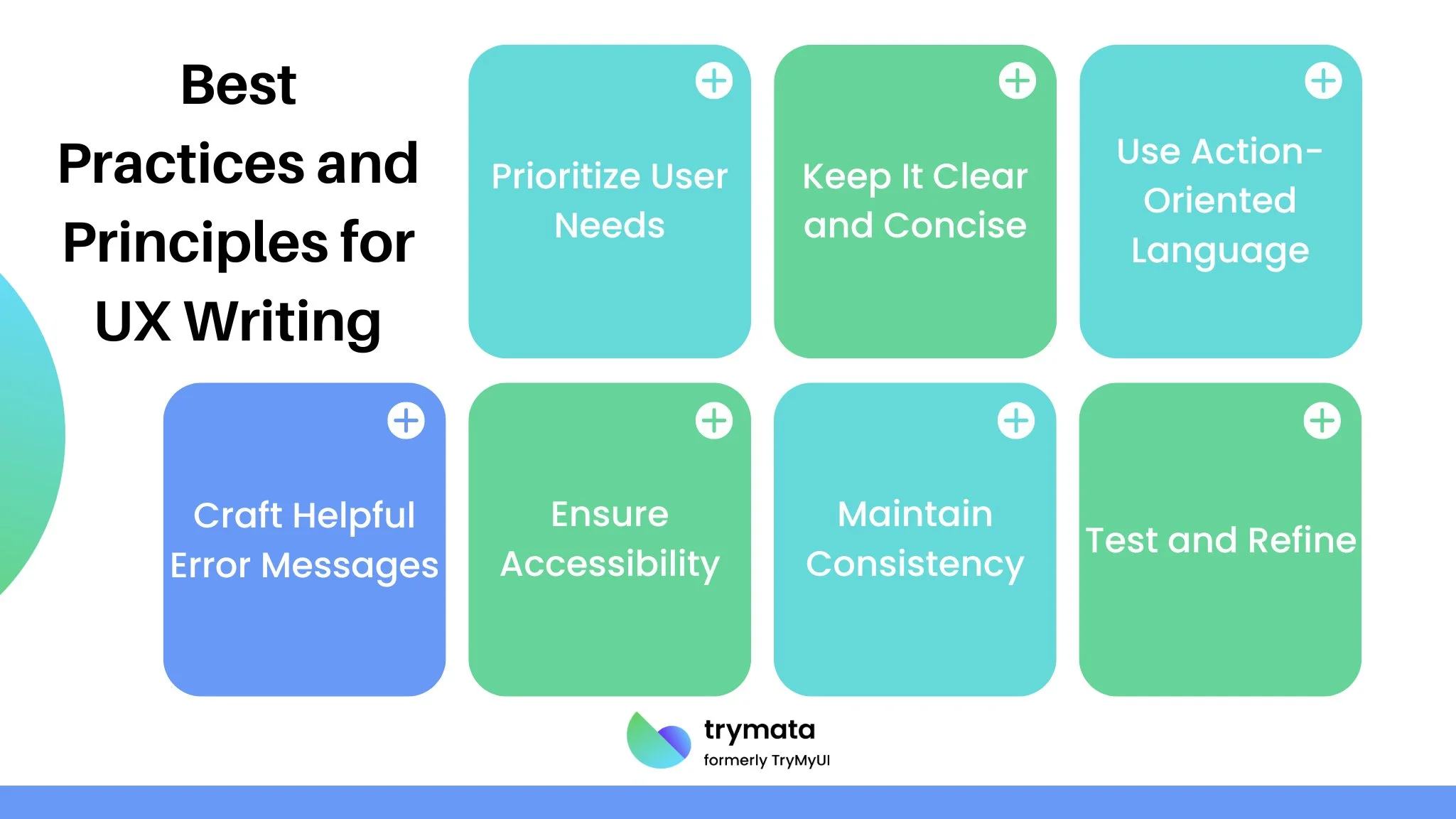Have you ever hesitated while using a website or app, unsure of what to do next? That’s where UX writing makes all the difference. Thoughtfully crafted UX copy removes confusion, ensuring users can navigate digital experiences effortlessly.
This blog breaks down what UX writing is, why it matters, and how to refine your writing for clarity and usability. You’ll also discover best practices, common pitfalls to avoid, and how UX writing overlaps with other content disciplines.
Whether new to UX writing or looking to improve your skills, this article will help you create content that guides, informs, and enhances the overall user experience.
What is UX Writing?
UX writing is crafting clear, concise, and useful text that helps users interact with digital products. It includes everything from button labels and error messages to sign-up forms and onboarding flows. UX writers focus on usability, ensuring that written content enhances the user experience.
Unlike traditional content writing, UX writing prioritizes functionality over storytelling. It guides users through digital interfaces, reducing friction and improving usability. A good UX writer ensures that users understand complex information quickly and efficiently.
How to Edit Your UX Writing
Editing UX writing is essential to crafting clear and effective content. Here are key steps to refine your UX writing:
- Remove Complex Language: Keep text simple and easy to understand.
- Ensure Clarity: Every word should serve a clear purpose in guiding users.
- Use Concise Sentences: Shorter text improves readability and reduces cognitive load.
- Maintain Consistency: Follow style guides to create uniformity across interfaces.
- Test for Usability: Conduct usability testing to check if users understand the message.
- Optimize for Readability: Consider how people read online and format content accordingly.
- Avoid Jargon: Use familiar terms to communicate messages.
- Align with Design Elements: Work closely with the design team to ensure the content fits seamlessly within the interface.
How Do You Know if UX Writing is for You?
UX writing might be right if you are passionate about problem-solving, content strategy, and guiding users through digital experiences. Consider pursuing a UX writing course to develop the necessary skills. You might enjoy the UX writing hub if you:
- Have strong writing and editing skills.
- Enjoy working with UX content designers and product managers.
- Understand how users interact with digital interfaces.
- Can break down complex information into digestible content.
- Appreciate usability testing and user research.
- Are interested in technical writing and content design.
- Want to contribute to a seamless digital experience?
Best Practices and Principles for UX Writing
Effective UX writing is about creating clear, user-friendly content that enhances digital experiences. Here are the key principles every UX writer should follow:

1. Prioritize User Needs
UX writing should always focus on the user, not just business goals. Avoid jargon and complex terminology. Instead, craft content that is simple, engaging, and relevant to the user’s journey.
2. Keep It Clear and Concise
Users don’t have time to decipher long or confusing text. Keep messages brief, direct, and easy to understand. Every word should serve a purpose, eliminating unnecessary fluff.
3. Use Action-Oriented Language
Users need clear direction. Strong calls to action, such as “Sign up,” “Continue,” or “Learn More,” make interactions intuitive and engaging. Avoid passive or vague phrases that leave users uncertain about the next step.
4. Craft Helpful Error Messages
Error messages should provide solutions, not just state problems. Instead of “Invalid password,” say, “Your password must have at least eight characters, including a number.” Clarity helps users resolve issues quickly.
5. Ensure Accessibility
Content should be inclusive and usable for everyone, including those with disabilities. Avoid complex wording and ensure that the text is readable for screen readers. UX writing should support all users, regardless of their abilities.
6. Maintain Consistency
Consistency across platforms and touchpoints builds trust. Adhering to style guides ensures uniformity in tone, terminology, and formatting, making the experience seamless.
7. Test and Refine
Great UX writing is never static. Conduct usability testing, analyze feedback, and refine content based on user interactions. Iteration ensures continuous improvement and a better experience for all.
By following these principles, UX writers can create content that enhances usability, reduces friction, and improves digital experiences.
Usability in UX Writing
Usability is essential in UX writing because poorly written content can confuse users and hinder their digital experience. Good UX writers ensure their content is intuitive and accessible.
Usability testing helps writers determine how effectively their content guides users through user interfaces. To enhance usability:
- Ensure all written content aligns with the design process.
- Write actionable, clear messages that help users understand what to do next.
- Conduct UX research to understand audience needs.
- Continuously optimize content based on user feedback and data.
Overlap Between UX Writing, Copywriting, and Marketing
When working in digital content, it’s crucial to understand how UX writing, copywriting, and marketing writing intersect. Each discipline plays a role in shaping the user’s journey but serves distinct purposes.
| UX Writing | Copywriting | Marketing Writing |
| Enhancing usability and user experience | Persuading and selling a product/service | Storytelling and brand awareness |
| Functional text like buttons, error messages, and navigation labels | Advertisements, email campaigns, and landing pages | Blogs, social media content, and case studies |
| Helping users navigate digital interfaces efficiently | Driving sales and conversions | Creating brand loyalty and engagement |
| Works closely with UX designers and product teams | Works with marketing teams and advertisers | Works with brand strategists and content creators |
While UX writing aims to guide users seamlessly through an interface, copywriting is designed to persuade, and marketing writing focuses on broader storytelling and brand positioning.
Difference Between UX Writing and Other Forms of Writing
UX writing also differs from other content disciplines such as technical writing and content design. Here’s how:
| UX Writing | Technical Writing | Content Design |
| Guides users through digital experiences | Explains complex information clearly | Structures content for accessibility and engagement |
| Concise, action-oriented | Detailed and explanatory | Strategic and structured |
| End-users interacting with a product | Professionals needing in-depth documentation | Product and UX teams creating digital experiences |
| Short-form content, microcopy, and interface text | Manuals, help documents, and technical guides | Web pages layout, app navigation, and information architecture |
Understanding these distinctions can help content professionals choose the right project approach. While UX writing prioritizes usability and seamless interactions, technical writing focuses on deep information clarity, and content design ensures an effective presentation of information within an interface.
Benefits of UX Writing
A strong UX writing strategy enhances digital products in multiple ways:
- Improves Usability: Helps users navigate interfaces effortlessly.
- Reduces Friction: Clear instructions prevent confusion and errors.
- Enhances User Experience: Creates a seamless interaction flow.
- Supports Business Goals: Well-written content contributes to conversions and retention.
- Strengthens Brand Voice: Consistent messaging builds trust and reliability.
- Saves Development Time: Well-structured content reduces revisions and misunderstandings in the design process.
Conclusion
UX writing is essential to UX design, ensuring that users understand and interact with digital products effortlessly. Whether you are interested in a UX writing course, exploring UX writer salary expectations, or enhancing your UX writing skills, the field offers rewarding opportunities.
A good UX writer collaborates with product managers, UX designers, and content strategists to create functional, user-friendly experiences. If you enjoy simplifying complex information, conducting usability testing, and guiding users through digital interfaces, UX writing could be the perfect fit for you.




